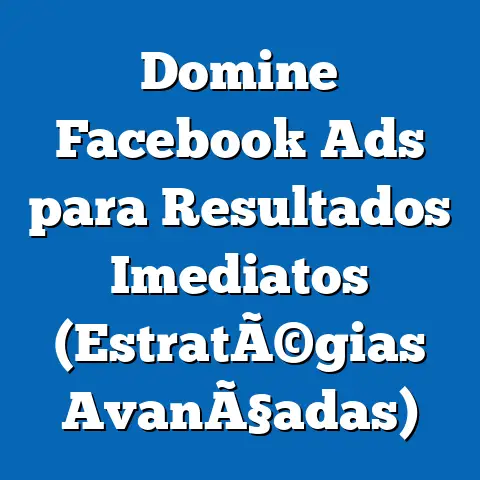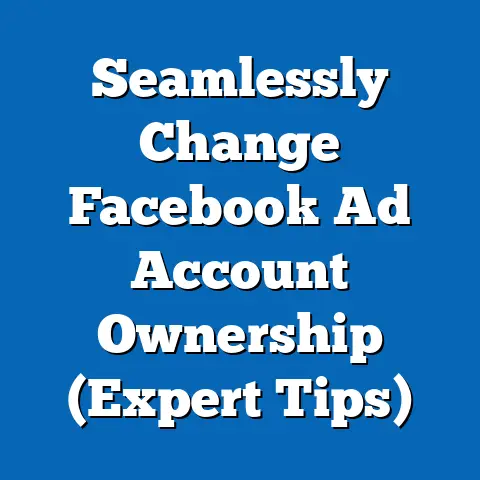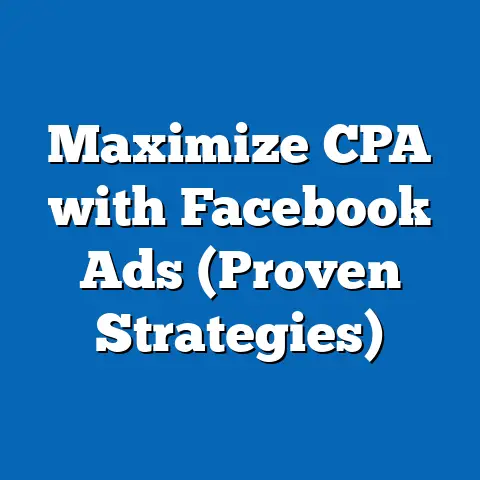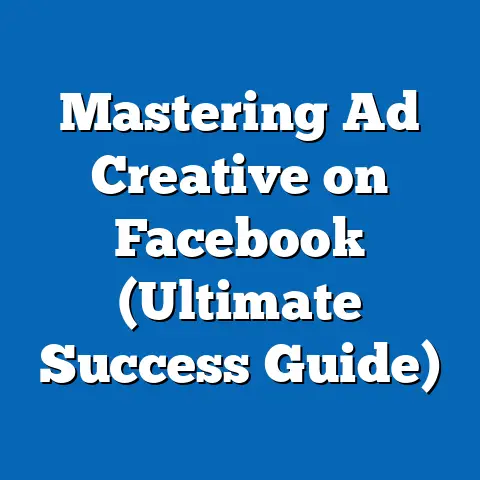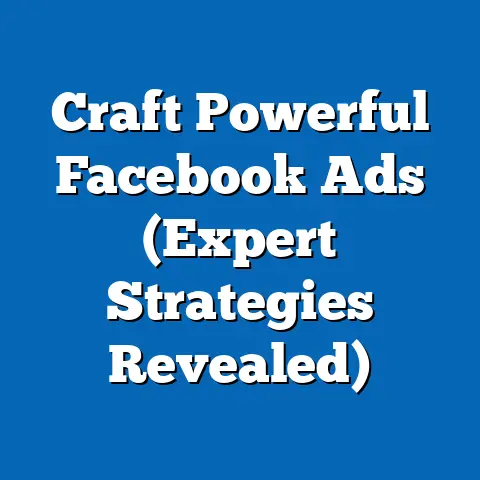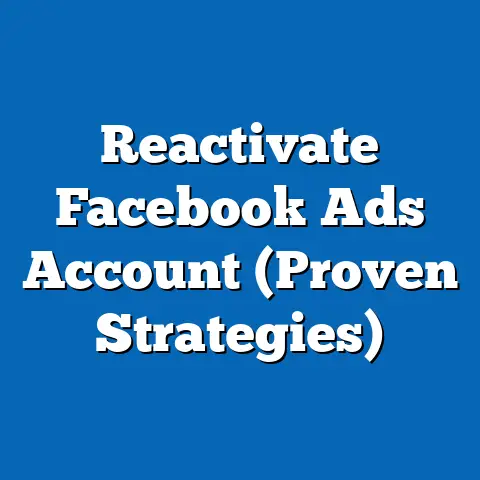Navigating Ads on Facebook (Expert Strategies Revealed)
“The consumer isn’t a moron, she’s your wife.” – David Ogilvy
Introduction
Facebook advertising isn’t just about throwing money at the platform and hoping for the best. It’s a complex ecosystem with incredible potential, but only when navigated with skill and precision. In today’s digital marketing landscape, mastering Facebook ads is no longer optional; it’s essential for businesses of all sizes looking to reach a massive and highly targeted audience. With over 2.9 billion monthly active users, Facebook offers unparalleled reach. But reach alone isn’t enough. You need the right strategies to convert that reach into meaningful results.
Understanding the Facebook Ads Ecosystem
Before diving into strategy, it’s crucial to understand the fundamental components of the Facebook advertising platform. Think of it as learning the rules of the game before you start playing. The Facebook Ads Manager is your central hub for creating, managing, and analyzing your ad campaigns. Within this hub, you’ll find a hierarchical structure that organizes your efforts:
- Campaigns: At the highest level, campaigns define your overall advertising objective. Are you aiming to increase brand awareness, drive website traffic, generate leads, or boost sales? Selecting the right campaign objective is crucial as it tells Facebook’s algorithm what you’re trying to achieve.
- Ad Sets: Within each campaign, you create ad sets. Ad sets control your targeting, budget, schedule, and placement. This is where you define your audience demographics, interests, behaviors, and connections. You also set your daily or lifetime budget and choose where your ads will appear (Facebook feed, Instagram feed, Messenger, etc.).
- Ads: Finally, within each ad set, you create individual ads. These are the actual creative assets that your audience will see. Ads consist of your ad copy, visuals (images or videos), and call-to-action buttons. You can create multiple ads within an ad set to A/B test different variations and optimize for the best performance.
Understanding how Facebook’s algorithm works is equally important. This algorithm determines which ads are shown to which users, based on a complex set of factors including bid amount, ad quality, and relevance to the target audience. Facebook prioritizes ads that provide a positive user experience, so creating high-quality, engaging content is essential.
Furthermore, it’s absolutely critical to familiarize yourself with Facebook’s advertising policies and guidelines. Violating these policies can lead to ad disapproval, account suspension, or even permanent banishment from the platform. These policies cover a wide range of topics, including prohibited content (e.g., hate speech, misleading claims), restricted content (e.g., alcohol, gambling), and data privacy regulations. I once had a client who ran into trouble because their ad copy made unsubstantiated health claims. It’s a common mistake, but one that can be easily avoided with a thorough understanding of the policies.
Takeaway: Familiarize yourself with the Facebook Ads Manager structure, understand how the algorithm works, and meticulously review the advertising policies before launching any campaign. This foundational knowledge will save you time, money, and potential headaches down the road.
Defining Your Goals and Target Audience
Before you even think about creating an ad, you need to answer two fundamental questions: What do you want to achieve? And who are you trying to reach? Without clear answers to these questions, your advertising efforts will be scattered and ineffective.
Setting clear, measurable objectives for your campaigns is paramount. Vague goals like “increase brand awareness” are difficult to track and measure. Instead, focus on specific, quantifiable objectives such as:
- Increase website traffic by 20% in the next month.
- Generate 50 qualified leads through a lead magnet offer.
- Achieve a 2x return on ad spend (ROAS) on e-commerce sales.
Having these specific objectives will allow you to track your progress and make data-driven decisions to optimize your campaigns.
Next, you need to identify and define your target audience. Who are the people most likely to be interested in your product or service? What are their demographics, interests, behaviors, and pain points? Facebook offers a wealth of targeting options, allowing you to reach very specific segments of users.
- Audience Insights: This tool provides valuable data about your existing audience or potential customers. You can explore demographics, interests, page likes, and purchase behaviors.
- Custom Audiences: This feature allows you to upload your own customer data (e.g., email lists, phone numbers) and target those users directly on Facebook. You can also create lookalike audiences based on your existing customers, expanding your reach to people who share similar characteristics.
Segmenting your audience is crucial for personalized messaging. Different segments will respond to different ad copy and visuals. For example, if you’re selling a fitness product, you might create separate ad sets for beginners, intermediate users, and advanced athletes, each with tailored messaging and images. I’ve found that segmenting based on purchase history or engagement level yields particularly strong results.
Takeaway: Define clear, measurable objectives for your campaigns and meticulously identify and segment your target audience. Leverage Facebook’s Audience Insights and Custom Audiences tools to gain a deep understanding of your ideal customers. The more specific you are with your targeting, the more effective your ads will be.
Crafting Compelling Ad Content
Once you have a clear understanding of your goals and target audience, it’s time to create compelling ad content that will capture their attention and drive action. Your ad copy and visuals are the first things potential customers will see, so it’s essential to make a strong impression.
Effective ad copy should be concise, engaging, and relevant to your target audience. Your headline should grab attention and clearly communicate the value proposition. Your description should provide more detail and highlight the benefits of your product or service. And your call to action (CTA) should tell users exactly what you want them to do (e.g., “Learn More,” “Shop Now,” “Sign Up”).
Here are a few tips for writing effective ad copy:
- Focus on benefits, not features. Explain how your product or service will solve a problem or improve their lives.
- Use strong verbs and action-oriented language.
- Keep it short and sweet. People have short attention spans, so get to the point quickly.
- Use a clear and concise call to action. Tell users exactly what you want them to do.
- Test different variations to see what resonates best with your audience.
Visuals are equally important in Facebook ads. High-quality images and videos can significantly increase engagement and click-through rates. Use visuals that are relevant to your target audience and that clearly communicate your message.
Here are a few best practices for using visuals in Facebook ads:
- Use high-resolution images and videos.
- Choose visuals that are eye-catching and engaging.
- Make sure your visuals are relevant to your ad copy.
- Test different visuals to see what performs best.
- Consider using video ads. Video ads are often more engaging than static images.
Let’s look at some examples of successful Facebook ads across different industries:
- E-commerce: An ad for a clothing brand might feature a stylish image of someone wearing their latest collection, with a headline like “Shop Our New Arrivals” and a CTA of “Shop Now.”
- Lead Generation: An ad for a software company might offer a free e-book or webinar in exchange for contact information, with a headline like “Download Our Free Guide” and a CTA of “Sign Up.”
- Local Business: An ad for a restaurant might feature a mouth-watering image of their signature dish, with a headline like “Try Our Award-Winning Pizza” and a CTA of “Order Now.”
The key is to create ads that are relevant, engaging, and visually appealing to your target audience. I’ve found that user-generated content (UGC) can be incredibly effective, as it feels more authentic and relatable than traditional advertising.
Takeaway: Craft compelling ad copy that focuses on benefits, uses strong language, and includes a clear call to action. Pair your copy with high-quality, engaging visuals that are relevant to your target audience. Test different variations to see what resonates best and continuously optimize your ad creative for maximum performance.
Budgeting and Bidding Strategies
Setting the right budget and choosing the right bidding strategy are crucial for maximizing your return on investment (ROI) on Facebook ads. You don’t want to overspend and waste money, but you also don’t want to underspend and miss out on potential customers.
Facebook offers two main budgeting options:
- Daily Budget: This sets the average amount you’re willing to spend per day on your ad set. Facebook may spend slightly more or less on any given day, but over the course of the month, your average daily spend will be close to your target.
- Lifetime Budget: This sets the total amount you’re willing to spend on your ad set over its entire duration. Facebook will optimize your spending to get the best results within your budget.
The choice between daily and lifetime budgets depends on your campaign goals and how much control you want over your spending. Daily budgets are generally better for ongoing campaigns, while lifetime budgets are better for campaigns with a specific end date.
Facebook also offers several bidding strategies, which determine how much you’re willing to pay for each ad impression or click. The main bidding strategies are:
- Highest Volume (Automatic Bidding): Facebook automatically sets your bids to get you the most results for your budget. This is a good option for beginners who are not familiar with manual bidding.
- Cost Per Result Goal (Automatic Bidding): Facebook aims to get you the most results while maintaining a specific cost per result (e.g., cost per lead, cost per purchase). This is a good option if you have a clear understanding of your target cost per result.
- Manual Bidding: You manually set your bids for each ad impression or click. This gives you more control over your spending, but it also requires more expertise.
Choosing the right bidding strategy depends on your campaign goals and your level of expertise. Automatic bidding is generally a good starting point for beginners, while manual bidding can be more effective for experienced advertisers who want more control.
It’s important to continuously test and adjust your budgets and bidding strategies based on performance data. Monitor your key metrics (e.g., cost per click, cost per conversion) and make adjustments as needed to optimize your ROI. I always recommend starting with a smaller budget and gradually increasing it as you see positive results.
Takeaway: Choose the budgeting option that best aligns with your campaign goals and level of control. Experiment with different bidding strategies to find the one that delivers the best results at the lowest cost. Continuously monitor your performance data and adjust your budgets and bids as needed to optimize your ROI.
A/B Testing and Optimization
A/B testing, also known as split testing, is a crucial process for refining your ad performance and maximizing your ROI. It involves creating two or more variations of your ad and testing them against each other to see which performs best.
The basic principle of A/B testing is to change only one variable at a time. This allows you to isolate the impact of that specific variable on your ad performance. For example, you might test two different headlines, two different images, or two different calls to action.
Here’s a step-by-step guide on how to set up A/B tests on Facebook:
- Create a new campaign or ad set.
- Choose your campaign objective and target audience.
- Create your first ad variation.
- Duplicate your ad and make changes to the variable you want to test.
- Set your budget and schedule.
- Launch your A/B test.
Some common variations to test include:
- Headlines: Try different headlines to see which grabs the most attention.
- Descriptions: Test different descriptions to see which communicates your value proposition most effectively.
- Images: Experiment with different images to see which resonates best with your audience.
- Calls to Action: Try different calls to action to see which drives the most clicks.
- Targeting: Test different targeting options to see which reaches the most qualified leads.
Once your A/B test has run for a sufficient amount of time (typically a few days to a week), it’s time to analyze the results. Look at key metrics such as click-through rate (CTR), cost per click (CPC), and conversion rate. The ad variation with the highest CTR and conversion rate is the winner.
Once you’ve identified the winning ad variation, you can use it as the baseline for future A/B tests. Continuously test and optimize your ads to stay ahead of the competition and maximize your ROI. I’ve seen campaigns completely transform after implementing consistent A/B testing strategies. It’s a continuous process of refinement.
Takeaway: Embrace A/B testing as a core component of your Facebook advertising strategy. Test different variations of your ads, analyze the results, and use the data to optimize your campaigns for maximum performance. Remember to only change one variable at a time to accurately measure the impact of each change.
Analyzing Performance and Insights
Analyzing your ad performance and leveraging Facebook’s insights is crucial for understanding what’s working and what’s not. Without proper analysis, you’re essentially flying blind and wasting money on ineffective ads.
Facebook provides a wealth of data about your ad performance, including:
- Reach: The number of unique people who saw your ad.
- Impressions: The number of times your ad was displayed.
- Click-Through Rate (CTR): The percentage of people who clicked on your ad after seeing it.
- Cost Per Click (CPC): The average cost you paid for each click on your ad.
- Conversion Rate: The percentage of people who completed a desired action (e.g., made a purchase, signed up for a newsletter) after clicking on your ad.
- Return on Ad Spend (ROAS): The amount of revenue you generated for every dollar you spent on advertising.
Facebook Analytics provides even more in-depth insights into your audience behavior and ad effectiveness. You can use Facebook Analytics to track website traffic, user engagement, and conversions. You can also create custom reports to track specific metrics and segment your data by demographics, interests, and behaviors.
It’s important to create regular reports and communicate your results to stakeholders. These reports should include key metrics, insights, and recommendations for future optimization. I recommend using a data visualization tool to present your results in a clear and concise format.
Takeaway: Regularly analyze your ad performance and leverage Facebook’s insights to understand what’s working and what’s not. Track key metrics, create custom reports, and communicate your results to stakeholders. Use the data to make informed decisions about your advertising strategy and continuously optimize your campaigns for maximum ROI.
Conclusion
Navigating the world of Facebook advertising can be challenging, but with the right strategies and a commitment to continuous learning, you can achieve remarkable results. Remember the key principles: Strategic planning, targeted messaging, and continual optimization.
By setting clear objectives, understanding your target audience, crafting compelling ad content, optimizing your budgets and bids, and continuously testing and analyzing your results, you can unlock the full potential of Facebook advertising and drive significant growth for your business.
The Facebook advertising landscape is constantly evolving, so it’s essential to stay updated with the latest features, trends, and best practices. Continuously experiment, learn from your mistakes, and adapt your strategies as needed to maintain a competitive edge. The strategies I’ve shared here are a starting point, a foundation upon which you can build your own unique and successful Facebook advertising approach. Now, go out there and conquer the Facebook advertising world!

